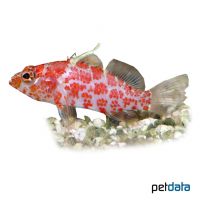Chequered Perchlet (Plectranthias inermis)
| Chequered Perchlet Plectranthias inermis | |
|---|---|
| Name | Chequered Perchlet |
| Name Lat. | Plectranthias inermis |
| Family | Sea Basses |
| Family lat. | Serranidae |
| Order | Perch-likes |
| Order lat. | Perciformes |
| Origin | Indo-West Pacific |
| Habitat | Reefs |
| Diet | Carnivore |
| pH | 8.1-8.4 |
| Hardness | 8-10 °KH |
| Behavior | Semi-aggressive |
| Keeping | Individual, pair |
| Reef Compatible | Yes |
| Care Level | Easy |
| Life Span | N/A |
| Protection | No |
| Metric Units | |
| Size | 4 cm |
| Temperature | 22-26 °C |
| Salinity | 33-36 ‰ |
| Aquarium | ~ 200 l |
| US Units | |
| Size | 2" |
| Temperature | 72-79 °F |
| Salinity | 1.020-1.025 sg |
| Aquarium | ~ 50 gal |
Distribution and habitat
The range of Plectranthias inermis extends from the coasts of Mauritius to the Christmas Islands, Indonesia and the Philippines to Papua New Guinea and the Fiji Islands. There they live on steep slopes of coral reefs and protected coastal zones mostly in depths between 14 and 65 m.
Maintenance
They require a well-structured aquarium with a reef structure that provides hiding, resting and retreat opportunities and medium to strong currents, as well as a deep substrate.
Only lime-rich, heavy metal-free sands, gravels, stones or sea sand may be used as substrate. Filters, skimmers and heaters are necessary to ensure water quality, as well as pumps to simulate tides, swells and bottom currents. It is recommended that live stones be used to furnish the aquarium. The bacteria living in the porous stones act as a biological filter. The lighting must correspond to the species-appropriate day-night rhythm of the animals
| Salinity: 33-36 ‰ | pH value: 8.1-8.4 |
| Carbonate hardness: 8-10 °KH | Nitrate content: 2-8 mg/l |
| phosphate content: 0.01-0.1 mg/l | nitrite content: 0.0-0.05 mg/l |
For salinity, an average value should be aimed for, which may only vary slightly by +/- 0.5 ‰. Ammonia and ammonium must not be measurable. Special attention must be paid to consistently good water quality and water values.
Diet
In nature they feed mainly on zooplankton. The feed change usually succeeds without problems. The food supply for these slow eaters should consist of a commercially available, vitamin-enriched frozen special food mix for plankton eaters or a combination of chopped shrimp and crab meat with live and frozen foods such as mysis, krill, bosmids, cyclops and Artemia. High quality flake and granular foods are also often accepted after a period of acclimation. It is recommended to feed small portions several times a day (3-5 times). This also reduces intra-species aggression. Regular and varied feeding promotes health and increases resistance.
Behaviour and compatibility
They usually live singly or in pairs, are very territorial within the species and consistently defend their territory. They are very suitable for a coral tank, but should not be socialized with fast eating fish and often behave aggressively towards gobies and blennies. Care should be taken when keeping them together with shrimp, as shrimp that are too small may be considered food.
Sex dimorphism
No external distinguishing characteristics are known. Males are usually larger.
Presumably they are protogynous hermaphrodites, i.e. males develop from functional females when needed
Reproduction and breeding
There are no known reports of successful breeding in the aquarium.
Important
They are very quiet and shy animals, which often show themselves only after days of acclimation in the aquarium.
As reef dwellers, they should only be kept together with corals and not in a fish-only aquarium. If different species are kept together, care should be taken to ensure that the fish match each other in terms of water quality and temperature requirements and social behavior, and that the setup meets the needs of all species kept together. New fish to be introduced must be acclimated slowly to the water in the aquarium
Further literature can be found in your pet store.
References
Text: Werner Winter; Image: petdata
Source: KUITER & DEBELIUS (2007): Atlas der Meeresfische: Die Fische an den Küsten der Weltmeere, Kosmos Verlag;
- Gemäß § 21 Abs. 5 Tierschutzgesetz idgF
